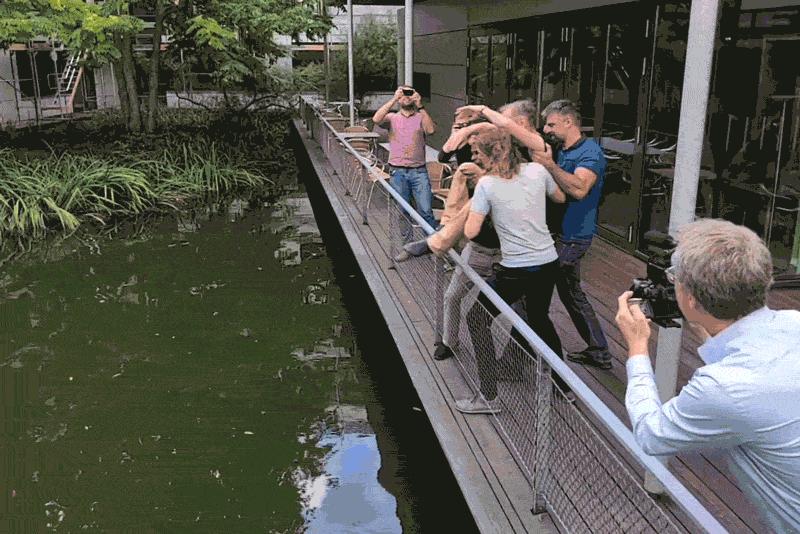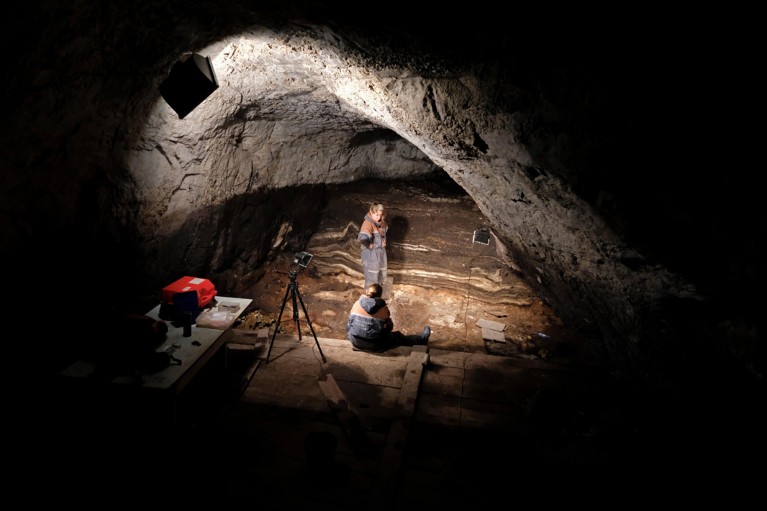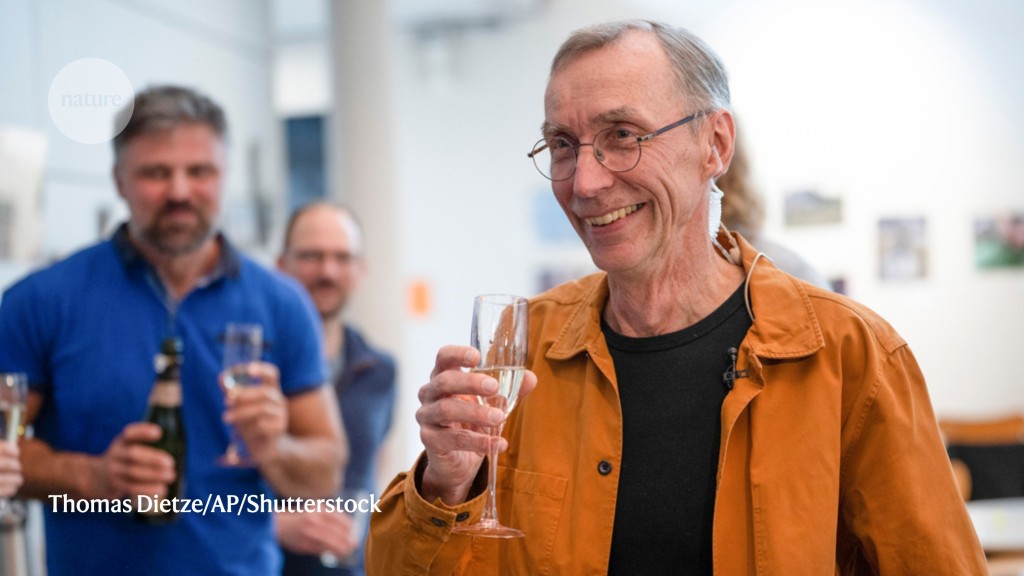[ad_1]

Swedish scientist Svante Paabo was awarded the 2022 Nobel Prize in Physiology or Medicine for his discoveries on human evolution.Credit: Thomas Dietze/AP/Shutterstock
Svante Pääbo, the winner of this year’s Nobel Prize in Physiology or Medicine, has pioneered efforts to recover DNA from ancient humans. His team at the Max Planck Institute for Evolutionary Anthropology in Leipzig, Germany, sequenced the first Neanderthal genome1 and identified a new group of ancient human, called Denisovans2, on the basis of DNA from a grape-seed-sized fleck of finger bone.
The geneticist tells Nature about plans to engineer Neanderthal-like tissues and how he ended up being hurled into a pond to celebrate winning his Nobel prize.
How did you end up in the pond?
It’s a tradition at our institute that you throw PhD candidates into the pond when they pass their exams. And some people had the idea that it would be appropriate to throw me into the pond. It was the second time, actually — there has been one crazy party before where that happened. But that’s a long time ago. I hope this is the last time I end up in the pond. But there’s a sauna on the roof of our institute, and that is very useful when you have been thrown into cold water.

Svante Pääbo celebrates his Nobel Prize according to tradition at the the Max Planck Institute for Evolutionary Anthropology in Leipzig, Germany.Credit: Benjamin Vernot
What inspired you to begin looking at genetic material from ancient humans?
As a kid, I always wanted to be an archaeologist or Egyptologist. And then I started studying that at university. But I had much too romantic ideas about what it would be like. I ended up studying medicine and molecular biology. And then the thought was not that far away that techniques were coming along to clone DNA and study DNA sequences from living organisms, and I wanted to see if it could also be done for tissue remains from archaeological and Egyptological collections.
Your field went through a crisis in the 1990s and 2000s, when a lot of ancient-DNA findings were affected by contamination. Was that difficult?
The very first ancient-DNA sequences I derived from an Egyptian mummy3 turned out to have been contamination from a present-day human. And then people started getting DNA from dinosaurs and inclusions in amber, things like that. That was when everyone felt that we needed more-stringent controls, and — when there are extraordinary claims — that things should be reproduced in a second laboratory. It’s not wrong to make honest errors in science as long as you are ready to correct them when you realize. We learn from the setbacks and can move forward.
What accomplishment are you most proud of?
The one moment that was probably the most amazing was getting the first DNA sequences from the mitochondrial genome of a Neanderthal4. We knew the variation among present-day human mitochondria. So we immediately realized that it was very human-like — but not like any human living today. That was the first time we realized that it was indeed a DNA sequence from an extinct form of human. We had a little bit of the genetic material of that individual, and that was emotionally quite a strong thing.
There was also the jaw-dropping discovery of the Denisovans — tell me about that.
That was when we had looked at the mitochondrial sequence, which showed a deep divergence from both humans and Neanderthals2. We later learned that this was a sister group to Neanderthals5, but at that time, it looked like it could be something like Homo erectus [a species ancestral to both humans and Neanderthals]. That was a tantalizing moment.

The Denisova Cave is the only known region where Neanderthals, Denisovans and modern humans are known to have lived in the same place.Credit: Eddie Gerald/Alamy
Since the discovery of the Denisovans, your career has become intertwined with Denisova cave in Russia. What makes this site special?
We don’t understand the factors, but there is a subset of fossils there that is extremely well preserved from a molecular perspective. It’s also the only place in the world where we have Neanderthals, Denisovans and modern humans that lived in the same place. And it’s where we have found a first-generation offspring of Neanderthals and Denisovans6. It is a very, very special place to be. I’ve been there three times.
What keeps you motivated?
I’m really focusing on the genetic changes that distinguish modern humans from Neanderthals. There was this recent paper we published in Science on a uniquely human mutation that makes more neurons during brain development when we put this change into a mouse or ferret7.
What’s the ultimate goal of these kinds of study?
We’ll probably never be able to fully understand what went on in the past, of course, but we might be able to understand some important aspects of it. I do think that there is something special about human sociality and modern human cognition, that we might be able to understand aspects of.
What about re-creating Neanderthal or Denisovan tissue?
To do that fully is probably beyond my lifetime in science. But one could dream about making all the changes in amino acids back to the ancestral state, for example. To do that would require making on the order of 100 changes in the genome. That is on the horizon of technology.
This interview has been edited for length and clarity.
[ad_2]

Swedish scientist Svante Paabo was awarded the 2022 Nobel Prize in Physiology or Medicine for his discoveries on human evolution.Credit: Thomas Dietze/AP/Shutterstock
Svante Pääbo, the winner of this year’s Nobel Prize in Physiology or Medicine, has pioneered efforts to recover DNA from ancient humans. His team at the Max Planck Institute for Evolutionary Anthropology in Leipzig, Germany, sequenced the first Neanderthal genome1 and identified a new group of ancient human, called Denisovans2, on the basis of DNA from a grape-seed-sized fleck of finger bone.
The geneticist tells Nature about plans to engineer Neanderthal-like tissues and how he ended up being hurled into a pond to celebrate winning his Nobel prize.
How did you end up in the pond?
It’s a tradition at our institute that you throw PhD candidates into the pond when they pass their exams. And some people had the idea that it would be appropriate to throw me into the pond. It was the second time, actually — there has been one crazy party before where that happened. But that’s a long time ago. I hope this is the last time I end up in the pond. But there’s a sauna on the roof of our institute, and that is very useful when you have been thrown into cold water.

Svante Pääbo celebrates his Nobel Prize according to tradition at the the Max Planck Institute for Evolutionary Anthropology in Leipzig, Germany.Credit: Benjamin Vernot
What inspired you to begin looking at genetic material from ancient humans?
As a kid, I always wanted to be an archaeologist or Egyptologist. And then I started studying that at university. But I had much too romantic ideas about what it would be like. I ended up studying medicine and molecular biology. And then the thought was not that far away that techniques were coming along to clone DNA and study DNA sequences from living organisms, and I wanted to see if it could also be done for tissue remains from archaeological and Egyptological collections.
Your field went through a crisis in the 1990s and 2000s, when a lot of ancient-DNA findings were affected by contamination. Was that difficult?
The very first ancient-DNA sequences I derived from an Egyptian mummy3 turned out to have been contamination from a present-day human. And then people started getting DNA from dinosaurs and inclusions in amber, things like that. That was when everyone felt that we needed more-stringent controls, and — when there are extraordinary claims — that things should be reproduced in a second laboratory. It’s not wrong to make honest errors in science as long as you are ready to correct them when you realize. We learn from the setbacks and can move forward.
What accomplishment are you most proud of?
The one moment that was probably the most amazing was getting the first DNA sequences from the mitochondrial genome of a Neanderthal4. We knew the variation among present-day human mitochondria. So we immediately realized that it was very human-like — but not like any human living today. That was the first time we realized that it was indeed a DNA sequence from an extinct form of human. We had a little bit of the genetic material of that individual, and that was emotionally quite a strong thing.
There was also the jaw-dropping discovery of the Denisovans — tell me about that.
That was when we had looked at the mitochondrial sequence, which showed a deep divergence from both humans and Neanderthals2. We later learned that this was a sister group to Neanderthals5, but at that time, it looked like it could be something like Homo erectus [a species ancestral to both humans and Neanderthals]. That was a tantalizing moment.

The Denisova Cave is the only known region where Neanderthals, Denisovans and modern humans are known to have lived in the same place.Credit: Eddie Gerald/Alamy
Since the discovery of the Denisovans, your career has become intertwined with Denisova cave in Russia. What makes this site special?
We don’t understand the factors, but there is a subset of fossils there that is extremely well preserved from a molecular perspective. It’s also the only place in the world where we have Neanderthals, Denisovans and modern humans that lived in the same place. And it’s where we have found a first-generation offspring of Neanderthals and Denisovans6. It is a very, very special place to be. I’ve been there three times.
What keeps you motivated?
I’m really focusing on the genetic changes that distinguish modern humans from Neanderthals. There was this recent paper we published in Science on a uniquely human mutation that makes more neurons during brain development when we put this change into a mouse or ferret7.
What’s the ultimate goal of these kinds of study?
We’ll probably never be able to fully understand what went on in the past, of course, but we might be able to understand some important aspects of it. I do think that there is something special about human sociality and modern human cognition, that we might be able to understand aspects of.
What about re-creating Neanderthal or Denisovan tissue?
To do that fully is probably beyond my lifetime in science. But one could dream about making all the changes in amino acids back to the ancestral state, for example. To do that would require making on the order of 100 changes in the genome. That is on the horizon of technology.
This interview has been edited for length and clarity.


Leave a Reply